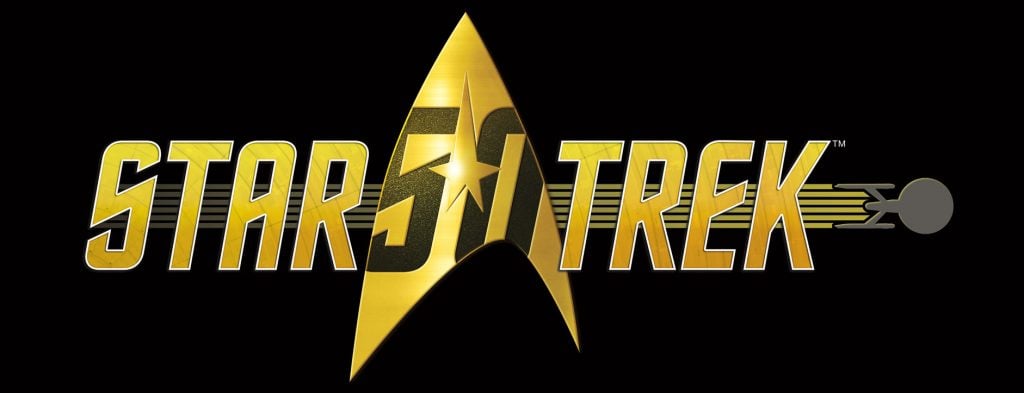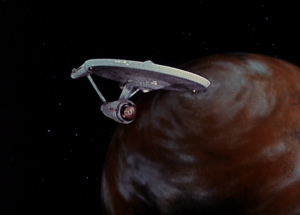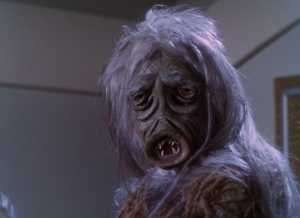
“Space, the final frontier…” Fifty years ago today, these words were beamed into our homes for the first time. In light of the occasion, we thought it would be fun to take a look at ‘The Man Trap’ – the first episode of ‘Star Trek’ to air – and see how it holds up five decades later.
First, some quick background. While ‘The Man Trap’ was the first episode to air, it was actually the sixth to be produced. While it wasn’t (and in some cases still isn’t) unusual to air episodes out of order, the decision to lead off with this episode was, as detailed by producers Robert Justman and Herbert Solow in the book ‘Inside Star Trek’, largely reached through the process of elimination. Of the earliest episodes, it was felt that ‘The Man Trap’ had the most straightforward plot. It also had the advantage of being finished. By contrast, ‘The Corbomite Maneuver’, despite having filmed much earlier, would not have its visual effects completed in time for the premiere date. And perhaps most importantly, it was one of the few episodes from that early production block to have scenes in which the crew actually leaves the Enterprise, thus allowing the series to showcase its mission statement of “strange new worlds”.
 The story begins as the Enterprise arrives at planet M-113 to resupply and medically evaluate an archeological expedition headed by Dr. Robert Crater and is wife Nancy, who was once involved with Dr. McCoy. Members of Kirk’s crew quickly begin to die mysteriously, their bodies apparently drained of salt. They soon realized that they are being stalked by a shapeshifting creature native to M-113. Kirk and Spock confront Dr. Crater, and learn that the creature is the last of its kind and that the woman they believed to be Nancy Crater was, in fact, the creature in disguise (the real Nancy having been killed several years prior). Since Nancy’s death, Crater has been supplying the creature with the salt it needs in return for its companionship. After returning to the ship with Crater, the crew begins to hunt the creature in earnest. Increasingly desperate, the creature kills Crater and prepares to attack McCoy. Kirk and Spock arrive at McCoy’s quarters in time to save him, but are nearly overwhelmed themselves before McCoy, at last convinced that this is not the real Nancy, forces himself to kill the creature in order to save himself, his friends and the entire crew.
The story begins as the Enterprise arrives at planet M-113 to resupply and medically evaluate an archeological expedition headed by Dr. Robert Crater and is wife Nancy, who was once involved with Dr. McCoy. Members of Kirk’s crew quickly begin to die mysteriously, their bodies apparently drained of salt. They soon realized that they are being stalked by a shapeshifting creature native to M-113. Kirk and Spock confront Dr. Crater, and learn that the creature is the last of its kind and that the woman they believed to be Nancy Crater was, in fact, the creature in disguise (the real Nancy having been killed several years prior). Since Nancy’s death, Crater has been supplying the creature with the salt it needs in return for its companionship. After returning to the ship with Crater, the crew begins to hunt the creature in earnest. Increasingly desperate, the creature kills Crater and prepares to attack McCoy. Kirk and Spock arrive at McCoy’s quarters in time to save him, but are nearly overwhelmed themselves before McCoy, at last convinced that this is not the real Nancy, forces himself to kill the creature in order to save himself, his friends and the entire crew.
So there you have it. That was the world’s introduction to ‘Star Trek’. How does it hold up after fifty years? Pretty well, if you ask me. While it’s not a no-holds-barred classic episode in the same sense as, say, ‘Balance of Terror’ or ‘Journey to Babel’, it is an excellent example of a “typical” ‘Star Trek’ episode. That is to say that you could show this to someone who has never seen ‘Star Trek’ before and they’ll walk away with a pretty good idea of what the series does. That being that, it can infuse even a relatively straightforward “monster stalking the crew” story with a measure of intelligent sci-fi. The M-113 creature is described as (and, indeed shown to be) “an intelligent animal,” established as the last of its species. Indeed, the creature is shown more as a desperate, cornered animal than as a malicious monster. This sympathetic portrayal is perhaps the single most “Star Trekish” thing the episode has to offer.
Earlier in this review, I talked about some of the advantages this episode had over others that filmed first. One thing I didn’t mention is the advantage of characterization. This was the sixth episode filmed, including the two pilots. That means, by the time ‘The Man Trap’ was filmed, the cast had already filmed three regular episodes, giving them some time to settle into their roles. And boy, does it show. From, their very first scene, Shatner and Kelley are on perfect form as Kirk and McCoy. Their easy banter establishes the relationship between the two men in the space of only a minute or two. In fact, this episode makes for an interesting choice of premieres for the fact that they launched the series with an episode in which the focal character is the ship’s doctor (a full year before DeForest Kelley would join Shatner and Nimoy in the opening credits), rather than the captain and star of the show.
 And then, of course, there’s Spock. What is there to say about Leonard Nimoy’s performance that hasn’t been said a thousand times before? There is, after all, a reason he was the breakout star of the series. And as with the friendship between Kirk and McCoy, Spock’s first scene tells you everything you need to know about him. In that scene, Uhura takes advantage of a dull moment on the bridge to try and flirt with Spock, an act which he very pointedly ignores. No sooner does Uhura return to her station than a call comes up from the transporter room, reporting that an unnamed member of landing party has been killed. Uhura is galled at Spock’s matter-of-fact response to this, pointing out that the dead man could just as easily be Captain Kirk. Ever logical, Spock reminds her that even if his friend is dead, “my demonstration of concern will not change what has happened.”
And then, of course, there’s Spock. What is there to say about Leonard Nimoy’s performance that hasn’t been said a thousand times before? There is, after all, a reason he was the breakout star of the series. And as with the friendship between Kirk and McCoy, Spock’s first scene tells you everything you need to know about him. In that scene, Uhura takes advantage of a dull moment on the bridge to try and flirt with Spock, an act which he very pointedly ignores. No sooner does Uhura return to her station than a call comes up from the transporter room, reporting that an unnamed member of landing party has been killed. Uhura is galled at Spock’s matter-of-fact response to this, pointing out that the dead man could just as easily be Captain Kirk. Ever logical, Spock reminds her that even if his friend is dead, “my demonstration of concern will not change what has happened.”
Certainly ‘The Man Trap’ isn’t without its flaws, but it is one of the stronger of the first wave of ‘Star Trek’ episodes, and despite the fact that it was never written as such, it works quite well as an introductory episode, laying important groundwork for a legacy that now spans half a century and counting.
Be sure to keep checking in with ScienceFiction.com throughout the day for our continuing coverage of the fiftieth anniversary of ‘Star Trek’.
Live long and prosper.
